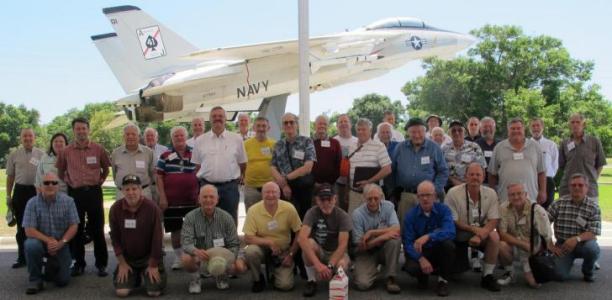

Photo Courtesy of Bill Brogdon (click for a larger image)
Courtesy of Bill Brogdon (click to animate, requires QuickTime
If you do not have QuickTime,here is a larger panorama)
AEHS Convention Highlights
2012 Convention
Report from 9th Annual AEHS Convention
Pensacola, Florida (May 9 - 12, 2012)
by Tom Fey, 18 May 2012
Program
 |
 |
| 2012 Convention Attendees at the National Naval Aviation Museum Photo Courtesy of Bill Brogdon (click for a larger image) |
2012 Convention Attendees Panorama Courtesy of Bill Brogdon (click to animate, requires QuickTime If you do not have QuickTime,here is a larger panorama) |
Traveling to Pensacola from Chicago by way of Atlanta took around four hours and was without hassle. The hotel shuttle got me to the hotel in time for the Wednesday night kick-off hors d’oeuvres and a chance to say hello to my fellow engine heads. Energy and smiles filled the ballroom, with Dave Birch and Fred van der Horst coming across the pond, and John Brand down from Toronto, to join the proceedings. Some members spent the early part of the week visiting Mobile, Alabama to see the battleship USS Alabama and Continental Motors, Inc. Pensacola is a clean town with water everywhere you look, and the Gulf Coast is mild, beautiful, and quiet in the calendar sweet spot between Spring Break and the Summer Occupation. The Crowne Plaza Pensacola hotel itself, the food, and the staff were outstanding, although the 5:40 am, (or was it 2:20 am?) freight train thundering by had some folks thinking Blitz! I never heard a thing. And they found and returned my coveted Miss Ashley II t-shirt to me long after I departed. So I’ll be back to this area for sure.
The talks this year were diverse and authoritatively presented: aircraft diesels, Sir Harry Ricardo, speed-density fuel controls, Merlin engine installation testing at Rolls-Royce, contra-rotating propeller aircraft, and the interesting geopolitical, national/commercial, and technical history of the ATAR series of turbojet engines. I’m not sure you could find such a line up anywhere else, and we are indebted to the presenters for their investment and excellence in their topics.
Breaks were filled with animated discussion and looking over two tables of items for silent auction. Movie night on Thursday was a smorgasbord of topics from aircraft and engine videos of every sort to paralyzingly funny English audio rendition ofThe Bricklayer. Outside the entertaining company of my fellow members and The Bricklayer, the true gem of the evening for me was a color film of the ground and flight testing of the XP-47H with the Chrysler XI-2220 engine in Evansville, Indiana. Let history note the darker quarter panels on the painted spinner are bright red.
The National Naval Aviation Museum (http://www.navalaviationmuseum.org) is a spectacular facility, with engines, aircraft, displays, mountable cockpit sections, and an IMAX theater that filled a half day but left much more to be explored. I never got to the outside aircraft park. Regrettably, the Maintenance Facility Hangar was not available to us, and that alone could have consumed a day. The fenced storage area held a treasure trove of dozens of intact aircraft (A-4s, Fat Albert, S2Fs, Neptune) as well as the Curtiss Helldiver that recently emerged from a California reservoir (http://www.utsandiego.com/news/2010/aug/20/world-war-ii-helldiver-bottom-lower-otay-lake). The SB2C-4 sat front and center right on trestles inside the gate, flanked by its demated engine and wing. The Museum resides on an active naval base, so wandering and poking around was not an option.
The Friday banquet was a wonderful affair where members got to meet the many spouses that accompanied the Society members. The food, like the facilities, set a new standard for our group, and the bartender kindly schooled the inept Midwesterners to master shucking and devouring the tasty red crawfish. I can eat kabobs in Chicago; to me and John Fowler, the crawfish were a menu expansion. Historian George Cully gave full diligence to another diverse topic, the aircraft range extension problem: 1939-1959, in the after dinner talk.
I wasn’t due to fly out until later Saturday, so I tagged along with Sam Ferguson who drove the 45 minutes east to the Air Force Armament Museum at Eglin AFB (http://www.afarmamentmuseum.com). The outside display aircraft were in excellent condition, and included the only long-tail SR-71, Spectre AC-130 gunship, CH-53 Super Jolly Green Giant, B-52, B-47, B-25, Mace and Hound Dog missiles on their unique transporters, and a pristine Mother of All Bombs (Actually MOAB – Massive Ordinance Air Blast). Inside, a two-seat Cavalier P-51 chase plane, P-47 Thunderbolt, F-80, and single seat F-105 occupied the floor space alongside every description of munition and air launched missile. The upper mezzanine around the main floor held even more displays and case, filled with weapons, cannons, mines, bombs, bomblets, etc. Although somewhat dark and hard to get good photographs, the diversity of items and the excellent data panels made for a very satisfying visit. Since reading a Viet Nam era book 25 years ago that mentioned “frozen” gravel mines that were used to cordon-off enemy access to downed airmen, I have wondered how they work and what they look like. Now I know.
Among the many pay-offs from attending all nine AEHS Convention, I now have a set of friends, no longer acquaintances, that share my interests, help me find information that I seek, share their knowledge, their pictures, and their friendship with me. And make no mistake; they are a lot of fun to be around.
So I thank the Society, its members, and especially Kim McCutcheon, for building a community of historic significance that adds greatly to my pursuit of happiness.
2012 Convention Sights
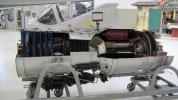 |
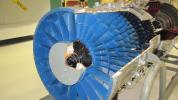 |
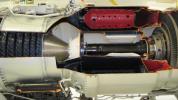 |
|
| Pratt & Whitney R-2800 Discussion | Pratt & Whitney J52 | Pratt & Whitney J52 | Pratt & Whitney J52 |
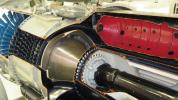 |
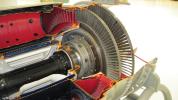 |
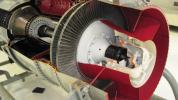 |
|
| Pratt & Whitney J52 | Pratt & Whitney J52 | Pratt & Whitney J52 | GE J79 Discussion |
More 2012 Convention Coverage in the Member's Section
2011 Convention
Report from 8th Annual AEHS Convention
Everett, Washington (August 17-20, 2011)
by Larry Rinek
Program
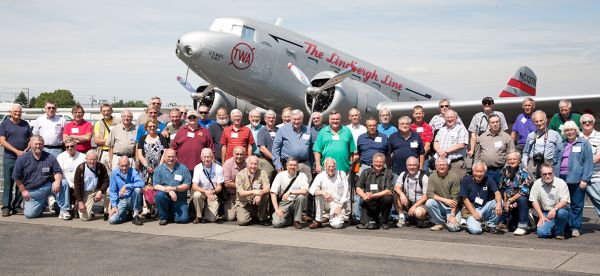 |
| 2011 Convention Attendees in front of the Seattle Museum of Flight Douglas DC-2 Photo Courtesy of Brian Silcox (click for a larger image) |
Your AEHS reporter enjoyed the 8th annual convention (I have attended all of them), and the weather was great—no rain and moderate temperatures in the great Pacific Northwest. We had a nice combination of presentations and local tours this year.
The turnout this year was 81 (defined as paid registered attendees and presenters plus spouses), not quite as high as the 84 for the 2010 convention. We do have fewer members tucked in the northwest corner of the continental U.S. The events kicked off with an evening gathering at the Holiday Inn convention site on August 17th, after we picked up our convention packets, with a large spread of appetizers plus a no-host bar. The room was full of buzzing members, guests and spouses.
The next morning on the 18th, President Kim McCutcheon launched the convention early (0800), with remarks on housekeeping/logistics, local travel plans/car pooling, and introductions all around the room. It was announced that speaker Mike Nixon was unable to attend the convention, so Dan Whitney moved up his talk to fill the time slot. The schedule was also advanced 30 minutes on Thursday morning, allowing more time for the visit to the Museum of Flight at Boeing Field later that day. A short break followed Kim’s remarks.
Then, at 0900 the convention kick-off speaker was yours truly, with a program entitled “Boeing’s Formidable B-52 Stratofortress Bomber.” Since the convention venue was Boeing country and the B-52 was born in Seattle (at the famous Boeing plant #2, which was demolished in November 2010), the topic was appropriate. I have been studying the B-52 for many years, and had multiple close encounters with the beloved BUFF (politely defined as the Big Ugly Fat Fellow) during my USAF active duty days as well as more recently as an aviation historian. With a PowerPoint slide show and a 1/100 scale detailed wooden model of a B-52H, I took the attendees through the program development, prototypes (models X and Y), technical innovations, production programs (models A through H), R&D derivatives, and combat history (starting in Southeast Asia in 1965 with Arc Light, on through Operation Enduring Freedom in Afghanistan). The program concluded with a breathtaking video of a B-52B takeoff filmed at Castle AFB (Atwater, Calif.) in 1956 (source was the DVD movie “Bombers B-52”, released to theaters in 1957), plus a memorable fast-moving B-52 slide show accompanied by music, prepared by Lt. Col. Keith Snyder (a B-52 aircraft commander).
Immediately after the B-52 program around 1030, the group enjoyed an early hotel-catered box lunch. Car pools then went down to the Museum of Flight at Seattle’s Boeing Field south of downtown. A group photo was taken shortly after arrival. Inside, museum docent and new AEHS member Mike Lavelle did a presentation on the Boeing Model 40 wood-frame mail plane. Kim McCutcheon then spoke about the Pratt & Whitney Wasp (R-1340) and Hornet (R-1690)/Hornet B (R-1860) radial aircraft engine programs. The R-1340 reportedly enjoyed the longest continuous production run of any aircraft engine (1925-1960), according to the P&W website.
Your diligent reporter stayed on site until closing time at 5 PM and beyond, taking many digital photos along the way. It had been many years since my last visit to this museum and the big change was the new facility to house the famed Champlin fighter collection (WW I and WW II focus) purchased by the museum years ago. I viewed the Champlin fighter collection back in 1994 at its previous home in Scottsdale, Arizona during the national convention of the American Aviation Historical Society (AAHS). The outdoor exhibits at the Museum of Flight were also noteworthy, including a well-restored B-17F bomber, WB-47E Stratojet bomber (I have a slide show on the innovative B-47, just like my B-52 program), a DC-3 with Wright R-1820s, a British Airways Concorde airliner, the original B747 airliner prototype, the first B727 airliner, a B707 VC-137B (Air Force 1 with President on board), and a classic L1049 Lockheed Super G Constellation airliner with four Wright R-3350 turbo compound radials. [side note: our family migrated from east coast to California on a TWA L1049 Super G back in 1957, I got a window seat to monitor those magnificent radials all the way to LAX!]
The Museum of Flight also has a weathered B-52G (on loan from the National Museum of the Air Force) parked up at Paine Field near Everett, fairly close to the Precision Engines hot test cell for rebuilt-radial engines (more on that later). Upon return to the hotel, the group was on its own for dinner. That evening, Kim McCutcheon showed three videos related to aircraft engines.
An unexpected bonus that evening was the live (and loud) engine demo out in back of the hotel, adjacent to I-5. Dixon Smith, owner and driver of the famous unlimited hydroplane boatMiss Bardahl (3-time National Champion during 1962 to1965), ran up his highly modified Rolls-Royce/Packard Merlin (V-1650) V-12 racing engine with short stacks, cooled by a convenient hotel garden hose water supply. Dixon reported to me that in its current tune it could deliver up to 2,400 hp with special racing fuel, and could propel his boat up to speeds of 150 mph. Note thatwww.missbardahl.com reported that the 7,000 lb, 30 foot racing boat originally had 3,000 hp and a top speed of 180 mph. At racing speed, only the lower prop blade (13” OD forged stainless steel hand-made prop) and twin sponsons of the hull are contacting the water as the boat almost floats on air. The unlimited turbine-powered hydroplane boats of today run in excess of 200 mph.
Early on Friday the 19th, attendees were treated to the Dixon Smith talk on racing modifications to R-R Merlins, with emphasis on racing boats, although air racing (Reno-type) modifications were also discussed. A certain Merlin steel quill shaft was notorious for failures, so the boating community came up with a very beefed-up original design, more robust than air racing versions. Another mod discussed was use of strong forged steel Allison connecting rods from the G6 series to replace weaker R-R rods, beginning around 1978. Since the Allison rods are 0.10 inch longer, pistons with a different wrist pin placement are needed. Another common mod was removal of the aftercooler, replaced by ADI to help cool the intake charge. The aero updraft carb needed to be switched to downdraft in boats. The boats were harder on the Merlins, racing at 4,000 RPM (not the 3,000 to 3,500 seen in air racing). A special gearbox is mounted to the marine Merlins that tripled the engine speed to the prop. Also, engine loads in the water varied while the boat moved around/up and down, unlike the steady prop load in air racing. Use of nitrous oxide injection for race boats was reviewed (Dixon had lots of hands-on experience dialing in the nitrous).
After the morning break, Dan Whitney stepped up to talk about modern propeller replacements for warbirds, such as the rare twin-engine (both Allison and R-R Merlin V-12 versions were built) P-82/F-82 twin-boom fighter that saw combat in Korea. The original Allison/Aeroproducts props are all gone, and Alcoa refused to forge aluminum blades for a left-hand (opposite) rotation. A skilled manufacturer of CNC-machined laminated wood “natural composite” props (MT-Propeller) stepped up and is seeking FAA type approval to run their new props (4-blade) on Allison V-12 engines, including those for flyable F-82s. A prototype test prop was flown on a P-51A Allison-engine fighter, to gather engineering data, and short videos of some airborne tests were shown.
After a box lunch, the group drove over to the local Paine Field for a guided tour of the Precision Engines radial rebuild facility. This shop does lots of work on P&W R-2800s and R-1830s, plus some work on Wright R-1820s and R-3350s (the latter for the huge Martin Mars forest fire water bomber/flying boat based in Canada). Small groups of people were also bused over to the hot test cell on the secured airfield, to observe a live demo of a freshly rebuilt R-1830 twin-row radial going through a test protocol. At our group visit, the mighty twin-row engine was loafing along at only 1,300 RPM, turning a special club prop. At full takeoff power settings, the short stacks reportedly become incandescent. Engines are run in this cell for many hours before delivery to the customer, with complete test documentation furnished.
The group also visited the Museum of Flight restoration facility at Paine Field. Among the notable aircraft parked in back were a rare Boeing 247D twin radial engine airliner, a Comet 4C jetliner (last of the series), the radial-engine Antonov An-2 (huge) biplane, a GM FM-2 Wildcat fighter, and a T-28 Trojan radial-engine trainer.
The evening concluded with the annual banquet (buffet-style). Clen Tomlinson of the UK delivered an informative talk on the history of D. Napier & Sons, which manufactured a wide variety of engineered hardware for over 100 years (such as motor cars, ammunition ball compressors, and printing presses) in addition to its aircraft engines (such as the famous Lion, that once held land-speed records). Clen urged AEHS members to join the Napier Heritage Trust (£10).
The final day of the convention (Saturday August 20) began with a memorable presentation by retired Pratt & Whitney executive Jack Connors on “The Engine for the B-52”, the twin-spool J57 turbojet story. He is an engine curator and a director of the New England Air Museum in Connecticut, venue for a prior AEHS convention. Jack’s exemplary hardback book,The Engines of Pratt & Whitney: A Technical History, published by the AIAA and available at Amazon.com, goes into much depth on the J57 development story, and all the key personalities involved. It was one of many valuable research sources for my B-52 talk. Since the B-52 program was cancelled & restarted a few times, and Pratt had no jet business with the USAF yet (GE/Allison locked up the Air Force, and Westinghouse locked up the USN) the whole opportunity was quite risky for P&W. One early iteration, the twin-spool JT3-10 (based on the proposed T-45 turboprop design) with a compression ratio of 10:1 did not make it to production. An enhanced “wasp waist” JT3A version with 12:1 compression did go into production for the B-52 (starting with 8,700 lb dry thrust) as well as USAF fighters, such as the North American F-100. Later, the turbofan version of the J57 (JT3D/TF33 with 17,000 lb thrust) was installed on the B-52 H model still flying today with 50-year old engine technology.
After the morning break, Fred van der Horst, retired radiologist (physician) from Holland, presented the BMW 801 twin-row radial engine history and development. The 801 is best known for service in the Fw-190 fighter that ravaged allied forces. Very detailed engineering drawings and photos that would delight any piston aircraft engine mechanic were presented. Especially unique was BMW’s single-lever Command Unit, a mechanical analog computer that relieved pilot work load by simultaneously controlling engine manifold absolute pressure (MAP), compressor stage selection, RPM, spark advance, air/fuel mixture, ADI (water/methanol injection) and/or nitrous oxide injection. Those parameters needed manual adjustment on U.S, and British aircraft piston engines of WW II, hard to execute in the heat of combat.
The complexity of the 801 engine was staggering: 18,000 parts, taking 16,000 man-hours to assemble by hand. BMW started out in radials with P&W-licensed Hornet designs and went on to build its own world-class radials with advanced features such as mechanical direct gasoline injection (to the combustion chamber). Allied engines adopted direct injection years later [note: the mighty P&W R-4360 corn-cob radial jumped from a 3,500 hp takeoff power rating to 3,800 for the B-36 with direct injection installed). The 801 started at 1,580 hp and at the end of WW II had 2,560 hp in development (not flown yet) with a 2-stage/4-speed supercharger. Altogether 30,000 BMW 801s were built.
After the annual silent auction was conducted by Tom Fey (all proceeds going to the AEHS), President Kim McCutcheon updated attendees on the state of the society, which just reached 10 years of age in July. Attendance is climbing again: as of July 2011, membership exceeded 950, up from 856 in December 2008. The AEHS financials are solid, now that the expense burden of publishing theTorque Meter has been removed. Kim re-worked the AEHS website with new software, now up and running. There was interest expressed in continuing the silent auction with more items for bidding, such as books. Kim appealed for new material to publish on the website, as re-publishing opportunities are diminishing. The U.S. Library of Congress decided to archive AEHS website material, quite an honor.
Regarding the 9th convention in 2012, our society president’s preference was Oshkosh, Wisconsin one week before the big annual fly-in. There were no objections by attendees. New hotels have been constructed in recent years—local housing used to be an issue. The EAA Museum at Oshkosh has some unusual exhibits. Since the east coast and west coast were the last two venues, it will be time for a mid-America convention. Southern venues, such as Pensacola, Florida (first-class Naval aviation museum) and the Commemorative Air Force (C.A.F.) museum/home base in Midland Texas, were discussed. However, both venues are considered stifling hot in the summer months—we would have to move the convention earlier or later in the year.
Many of us drove back to Paine Field right after the convention to visit the Flying Heritage Collection. The site was mobbed as flights of WW II vintage aircraft were seen live that day. In the morning, two Spitfires (one British, the other in Czech military livery) plus a German Me/Bf-109 fighter were reportedly flown. Just as I arrived and parked, a magnificent Boeing B-17G taxied in (with paying passengers), followed later by its companion North American B-25J, both on tour for the C.A.F. They parked and I got photos, to be posted to the AEHS website. A pilot for the B-17G reported to me that they fly with 100LL avgas, and he was able to pull full MAP (as for takeoff) without problems.
2011 Convention Sights
More 2011 Convention Coverage in the Member's Section